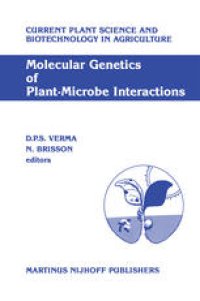
Ebook: Molecular genetics of plant-microbe interactions: Proceedings of the Third International Symposium on the Molecular Genetics of Plant-Microbe Associations, Montreal, Quebec, Canada, July 27–31, 1986
- Tags: Plant Sciences
- Series: Current Plant Science and Biotechnology in Agriculture 3
- Year: 1986
- Publisher: Springer Netherlands
- Edition: 1
- Language: English
- pdf
Increased interest in the basic biology of plants and microorganisms stems from the fact that crop productivity is directly affected by plant-microbe interactions. In spite of the fact that plants exist in the environment amongst diverse species of microorganisms, only a few ever establish a direct relationship. Emerging awareness concerning the indirect effect of microbial association on plant growth and the possibility of using one microbe against another for controlling pathogenic interactions is at the genesis of new fields of studies. The primary reason for a microbe to associate with· photoautotrophic organisms (plants) is to tap its nutritional requirements, fixed carbon, as a source of energy. By hook or by crook, a microbe must survive. Some have evolved mechanisms to exploit plants to develop a niche for their biotropic demands. When in contact with a living plant, microorganisms may live in a passive association using exudates from the plant, invade it pathogenically or coexist with it in symbiosis. The plant responds to the interloper, either reacting in a hypersensitive manner to contain the invasion of pathogens, or by inducing a set of genes that leads toward symbiosis, or by simply succumbing to the invader. Thus, prior to contact wi th the plant, mic roorganism is able to sense the presence of the host and activate accordingly a set of genes required for the forthcoming interaction, whether symbiotic or pathogenic.
Content:
Front Matter....Pages I-XXXII
Front Matter....Pages 1-1
Ecology of Agrobacterium: Plasmids and Biovars....Pages 3-5
The Agrobacterium Rhizogenes Root-Inducing System....Pages 6-10
Effect of the Presence of the Plasmid pSA and of Auxin on the Attachment of Agrobacterium Tumefaciens to Plant Host Cells....Pages 11-13
Dual Regulation of Virulence Genes of Agrobacterium Plasmid pTiC58....Pages 14-19
Mammalian Metallothionein Functions in Plants....Pages 20-26
Tumorigenesis and root nodulation by Agrobacterium tumefaciens carrying Rhizobium sym plasmids....Pages 27-31
Front Matter....Pages 32-34
Cutinase and Pectinase in Host-Pathogen and Plant-Bacterial Interaction....Pages 35-40
Siderophore Biosynthesis, Uptake and Effect on Potato Growth of Rhizosphere Strains....Pages 41-41
A Gene Cluster in Xanthomonas campestris pv campestris Required for Pathogenicity Controls the Excretion of Enzymes....Pages 43-50
Direct Analysis of the Invasiveness of Xanthomonas Campestris Mutants Generated by Tn4431, A Transposon Containing A Promoterless Luciferase Cassette for Monitoring Gene Expression....Pages 51-53
Front Matter....Pages 54-56
Induced Symbiosis Mutants of Pisum Sativum....Pages 57-60
Plant Host Genetics of Nodulation Initiation in Soybean....Pages 61-66
A Mutant of Pea (Pisum sativum) Possibly Disturbed in the Production of a Compound Required for the Induction of Nitrogenase Activity in Bacteroids....Pages 67-72
Non-Nodulation Mutants of Soybean....Pages 73-75
Early Nodulins in Root Nodule Development....Pages 77-77
Front Matter....Pages 79-84
Peribacteroid Membrane Nodulins of Soybean....Pages 85-90
Isolation of Nodule Specific c-DNA Clones from Medicago sativa....Pages 91-93
Analysis of Nodule-Specific Gene Expression in Ineffective Alfalfa Root Nodules and Callus Cultures Derived from Ineffective Root Nodules....Pages 94-95
Investigation of Plant Genes Expressed During Symbiotic Nitrogen Fixation....Pages 96-101
Four Soybean Nodulin Genes Evolved from a Common Ancestor....Pages 77-77
Coordinated Expression of Nodule-Specific and Root Genes in Yellow Lupin....Pages 102-107
Expression of Two Enzymes Involved in Ureide Formation in Soybean Regulated by Oxygen....Pages 108-111
Probing Cell Wall Structure in the Soybean Root Nodule....Pages 112-114
Monoclonal Antibodies to Components of Rhizobium-Induced Pea Nodules....Pages 115-117
Localization of the Glutamine Synthetase Polypeptides in Phaseolus Root Nodules....Pages 118-119
Changes in Protein and mRNA Accumulation in Potato Tubers Treated with an Elicitor....Pages 120-122
Front Matter....Pages 123-126
Organization of the Rhizobium Phaseoli Genome....Pages 127-129
Symbiotic Mutants of Rhizobium Meliloti Which Produce Non-Succinylated Exopolysaccharide....Pages 130-132
Front Matter....Pages 133-137
Analysis of Three Rhizobium phaseoli Genes, psi, psr and pss, Which Affect Exopolysaccharide Synthesis and Symbiotic Nitrogen Fixation and/or Nodulat Ion....Pages 138-140
Involvement of pSYM Nodulation Genes in Production of Surface and Extracellular Components of Rhizobium trifolii Which Interact With White Clover Root Hairs....Pages 141-141
Rhizobium Exopolysaccharides are Essential for the Formation of Nitrogen Fixing Nodules in the Rhizobium-Legume Symbiosis....Pages 142-144
Surface Properties of Rhizobium meliloti Associated with Symbiosis....Pages 145-148
Identification of Host Specificity DNA Regions Determining the Broad Host Range Nodulation of Rhizobium Strain NGR234....Pages 149-149
Characterization of Genes Essential for Symbiotic Nitrogen Fixation From Bradyrhizobium japonicum Strain I110....Pages 151-156
Nodulation Genes of the Stem Nodulating Sesbania Rostrata Symbiont, Strain ORS571....Pages 157-158
NOD-Linked Host Specific Gene for Soybean (Peking) Nodulation in Rhizobium Fredii USDA193....Pages 159-161
Common and Host Specific Nodulation Genes in Rhizobium Meliloti and Their Conservation in Other Rhizobia....Pages 162-164
Interactions Between Rhizobium Meliloti and Rhizobium Trifolii Nodulation Genes: What is the Basis for Dominance by R. Meliloti?....Pages 165-166
Multiple Host-Specificity Loci in the Broad Host-Range Rhizobium NGR234....Pages 167-168
Conserved Nodulation Genes are Obligatory for Nonlegume Nodulation....Pages 149-149
Characterization of Symbiotic Genes and Regulation of Their Expression in Rhizobium Leguminosarum PRE....Pages 169-170
Front Matter....Pages 171-172
Naringenin Induces the nodABC Promotor of Rhizobium Leguminosarum as Well as Tsr Factor Production....Pages 173-178
The Unusual Symbiosis Between the Nitrogen Fixing Bacterium ORS571 and Its Host Sesbania Rostrata: Regulation of Nitrogen Fixation and Assimilation Genes in the Free Living Versus Symbiotic State....Pages 179-181
Analysis of Azorhizobium Sesbaniae ORS571 N2 Fixation Genes....Pages 182-184
Identification, Characterisation and Sequence Analysis of the Rhizobium Leguminosarum NifA Gene....Pages 185-187
Analysis of hup DNA and Hup host range of Rhizobium leguminosarum BIO....Pages 188-190
Bioluminescence in Root Nodules of Soybean Controlled by Nitrogenase Promoters....Pages 191-196
Genes for the Catabolism and Synthesis of a Nodule-Specific, Opine-Like Compound are Closely Linked and on the Sym Plasmid of Rhizobium Meliloti....Pages 197-201
Front Matter....Pages 202-207
Use of Heterologous Hybridization in Phylogenetic Studies of Symbiotic Anabaena Strains....Pages 208-210
Front Matter....Pages 211-213
Role of VIR Genes in the Excision of T-DNA from the Ti-Plasmid....Pages 214-216
Cloning Vectors for Coryneform Bacteria....Pages 217-222
Cloning of Serratia Liquefaciens Chitinase Gene(s)....Pages 223-224
Back Matter....Pages 225-228
....Pages 229-231